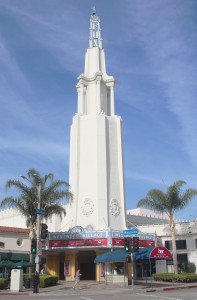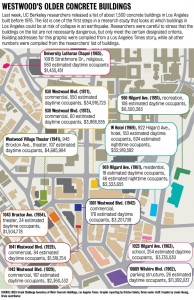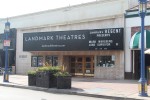Thirteen Westwood buildings near UCLA could be vulnerable to collapse in a high-magnitude earthquake based on the findings of a larger study of old, concrete buildings in Los Angeles.
A team of UC Berkeley researchers released a list this month of about 1,500 concrete structures in Los Angeles built before 1976, the year the city of Los Angeles modernized building regulations.
Of the buildings identified by the study, several are Westwood landmarks, including Bank of America, the Landmark Regent Theatre, the W Hotel and the Westwood Village Theater.

The buildings studied by UC Berkeley are nonductile, meaning that the concrete lacks reinforcement and is possibly susceptible to earthquake damage.
Jack Moehle, a UC Berkeley engineering professor who helped compile the list, said concrete buildings in Los Angeles could be at a higher risk than other buildings because of the region’s seismic volatility. Much of the California coastline sits on a fault line that has caused destructive earthquakes in the past.
Researchers from UC Berkeley maintain that the list is not definitive and that the buildings are not necessarily dangerous. More detailed surveys of the individual buildings are necessary to determine the risk associated with the structures, they said.
The study was designed to improve current risk assessment tools used to determine the possibility of a building’s collapse during earthquakes.
University, government and other public buildings were reviewed for the list but not included because they underwent earlier retrofitting or information was not available.

“It’s really alarming to me,” said Hasti Daneshvar, a UCLA alumna and Westwood resident who frequents some of the buildings on the list.
Daneshvar said she was concerned for the safety of her two children who attend school in Westwood.
“I wouldn’t move to a building on the list,” she added.
Also on the list is Park Westwood Tower, a residential building on Hilgard Avenue with 135 units. Bill Brick, the building’s manager, said three residents have already approached him to express concerns about the building’s safety.
He added that the tower is currently being evaluated to determine the cost of a structural update. Once the evaluation is complete, the tower’s homeowners association will vote on whether to retrofit the building, Brick said.
The W Hotel on Hilgard Avenue was evaluated by a structural engineer last year to determine if structural modifications are needed, Brad Wulff, the marketing manager of the hotel, said last week.
The CVS Pharmacy on Westwood Boulevard was also among the listed buildings. Several customers and staff were unaware that the list existed and were shocked to learn that the pharmacy is one of the buildings on the list.
While some people said they were concerned about the safety of the building, the majority of them were undeterred by the building’s age and concrete structure.
“I would come back. I’m only in here for a few minutes,” said Victoria Wilken, a third-year psychology student.
In a separate analysis, Los Angeles Times researchers examined buildings that were likely to fit the criteria of the Berkeley list, including 924 Westwood Boulevard, a building owned by the UC Board of Regents. However, it was not identified in the list released by UC Berkeley.
UCLA spokesman Steve Ritea said the building was retrofitted in 1990 and is in the process of upgrading its infrastructure again.
City officials requested a copy of the list released by UC Berkeley but have yet to decide the next step in ensuring the safety of Angelenos.
“It’s a good wake up call for everyone in L.A.,” Daneshvar said.
Managers at Bank of America, CVS Pharmacy, the Landmark Regent Theatre and Westwood Village Theater said they had no comment on the study.
